Block Maze
| Author: |
Yasuyuki Ogata |
| Release: |
"POPCOM" Aug. 1986 Issue |
| Program length: |
17 screens |
The game:
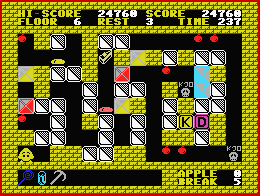 |
The objective of the game itself is to get the keys and get to the door, however, they are not present from the beginning. The door will not appear until you get the 8 apples, and the key is hidden in the "K" block. After the block with a letter on it must be pushed until it reaches the light blue block, it disappears and its content appears. Similarly, a pickaxe is hidden in "B" block, and an apple is hidden in "A" block. Each pickaxe can break a wall up to five times, but that remaining number of times does not be restored when advancing to the next floor, so it should be saved as you can. "D" block makes a door appear regardless of the number of apples. |
You can pass over light blue, yellow, and red blocks, but you will die if you are caught between one of them and another block.
Each time you pass over a yellow or red block, a wall or block appears to the right of it..
The 1st file (The "checksum" program):
You don't create this file if you use "DumpWithRTCS" described below.The 2nd file:
Particular attention should be paid when typing the following line. (This information was provided in the August 1986 issue.)It would be better if you modify the code as below.
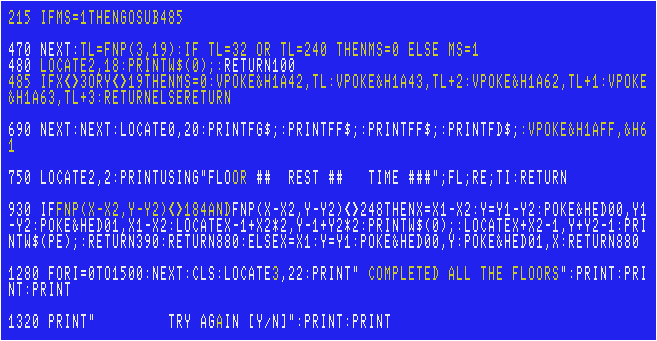
Issue 1 (fatal one):
The starting point for each floor is always the lower left corner of the map, but if you die while placing a block there, that block will disappear.
If a normal block disappears, it would be a great help, but if an important block such as "K" block disappears, it becomes impossible to complete the game.
So we should made it so that all but the normal block are restored the moment the player character moves from the starting point after the game restarts.
(The lines #215, #470, #480 and #485.)
Issue 2 (fatal one):
Because a door can be erased by pulling a block, the floor can never be completed.
Only if the door can be erased, we should make it so that the block can no longer be pulled. (The line #930.)
Issue 3:
There was a blank space for one character in the lower right corner of the screen. (The line #690.)
Other minor issues: The author's typos or strange English. (The lines #750, #1280 and #1320.)
For disk users:
This game is originally for tape only. This is because part of the program's area of use overlaps with the 1st disk's work area.
To load the game on Disk Basic, modify the code as below.

If you modify the code as described above, each checksum will change as follows (using version3.1 coded by the "MSX•FAN" team).
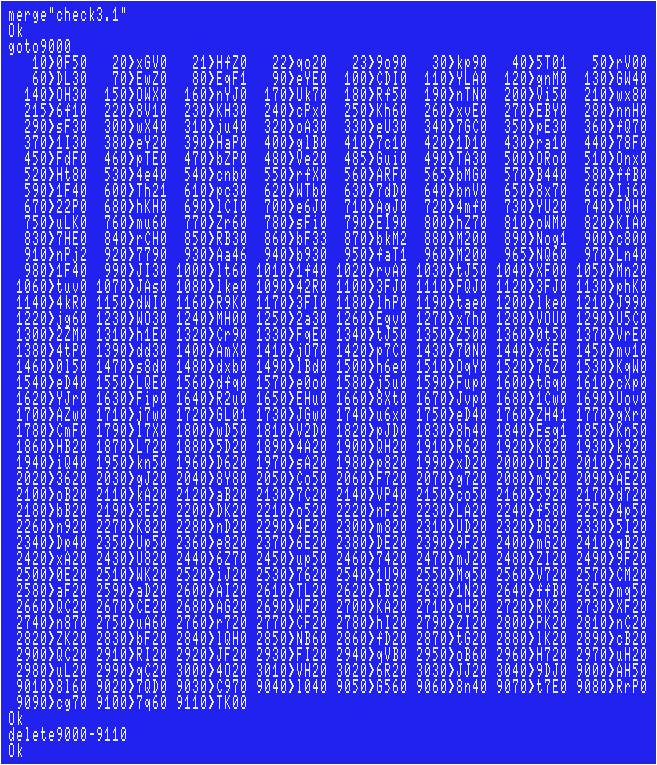
Sorry if there are any typos, however, I tested my data, including the ending, and had no problems.
The 3rd file named "BL-MAZE.BIN":
You cannot even save this dump file on Disk Basic using the monitoring program coded by MSX Magazine.First, enter all data using a binary editor on Windows to create one.
In such cases, we Japanese usually use freeware called "DumpWithRTCS".
Choose "Tool(T)">"Address Offset(A)...". Enter "EE00". Then enter all hexadecimal numbers to F27FH.
Don't forget to compare each checksum with that in the magazine. (Choose "Checksum(C)">"Add8(E)")
Finally add a header. (FE00EE7FF200EE)
To load the game, run the 2nd file.
Joystick support:
The 2nd file: Modify the code as below.
The 3rd file: Modify the code as below.

Trigger 1: Yes., Trigger 2: No.
For Amiga CD32+FDD users and SNES+AD adapter users:
Unfortunately, neither "AmiMSX", "fMSX"(Amiga port), nor "MSXAdvance" can emulate "On Sprite Gosub" command.When you use "AmiMSX" or "fMSX"(Amiga port), nothing happens even though your main character collides with an enemy.
The only way to solve the root problem is to delete that "On Sprite Gosub" and define collision detection by specifying coordinates instead.
Modify the code as below.
For 020 CD32 users, it also needs the following modification because the time speed is faster than the player's one.

Maze
| Author: |
Mr. Tanuki |
| Release: |
"POPCOM" Dec. 1987 Issue |
| Program length: |
33 screens |
The 1st file named "MAZEFONT.BAS":
Original file name was "FONT", but I'm assuming that you're managing a huge amount of MSX games' files.To load the game from your diskette, modify the line #120 as below.
If you modify the code as described above, each checksum will change as follows (using version3.1 coded by the "MSX•FAN" team).
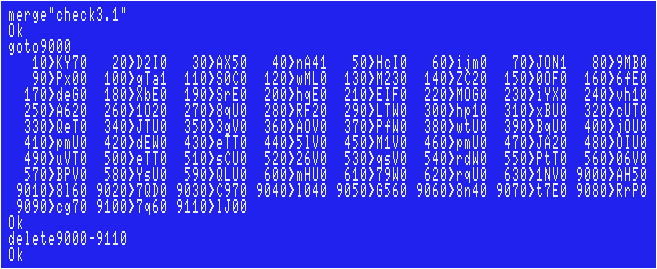
Sorry if there are any typos, however, I tested my data, including the ending, and had no problems.
The 2nd file named "MAZE-MN.BAS":
Original file name was "MAZE", but I'm assuming that you're managing a huge amount of MSX games' files.The lines #790, #820, #880, #910, #920, #1230 and #1240: CHR$(45) is used. CHR$(176) is not used.
Particular attention should be paid when typing the following line.

To load the game from your diskette, modify the lines #1020 and #1025 as below.
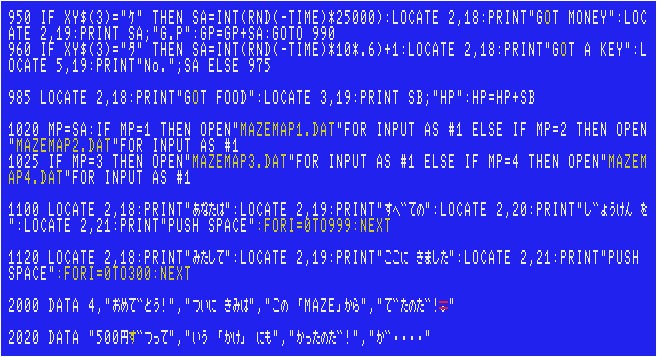
It would be better if you correct minor typos / issues described above.
If you modify the code as described above, each checksum will change as follows (using version3.1 coded by the "MSX•FAN" team).
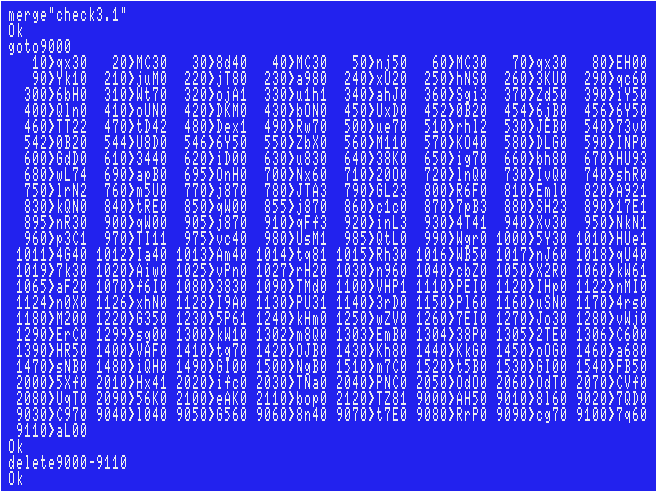
Sorry if there are any typos, however, I tested my data,including the ending, and had no problems.
The 3rd file named "MAZESAV1.BAS":
Original file name was "SAVE1", but I'm assuming that you're managing a huge amount of MSX games' files.To load the game from your diskette, modify the line #1060 as below.
If you modify the code as described above, each checksum will change as follows (using version3.1 coded by the "MSX•FAN" team).
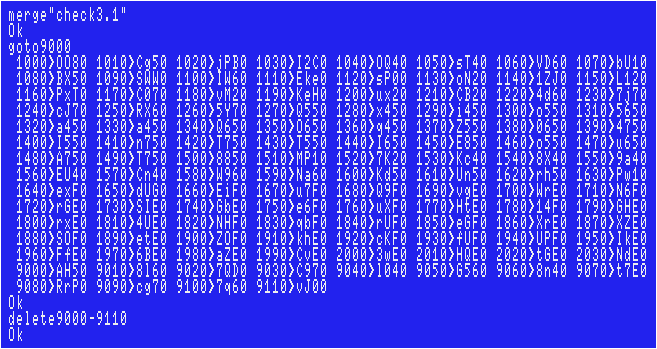
Sorry if there are any typos.
Run this file. "MAZEMAP1.DAT" will be created on the same diskette.
The 4th file named "MAZESAV2.BAS":
Original file name was "SAVE2", but I'm assuming that you're managing a huge amount of MSX games' files.To load the game from your diskette, modify the line #1060 as below.
If you modify the code as described above, each checksum will change as follows (using version3.1 coded by the "MSX•FAN" team).
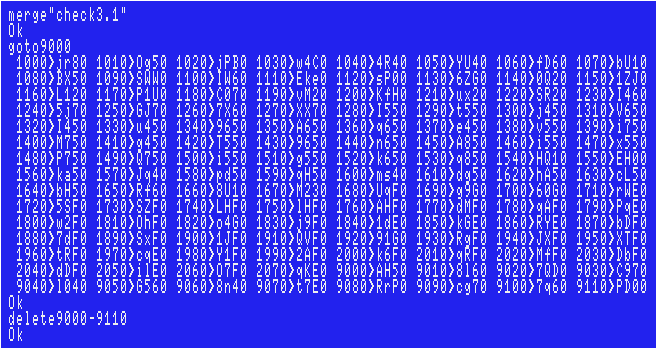
Sorry if there are any typos.
Run this file. "MAZEMAP2.DAT" will be created on the same diskette.
The 5th file named "MAZESAV3.BAS":
Original file name was "SAVE3", but I'm assuming that you're managing a huge amount of MSX games' files.To load the game from your diskette, modify the line #1050 as below.
If you modify the code as described above, each checksum will change as follows (using version3.1 coded by the "MSX•FAN" team).
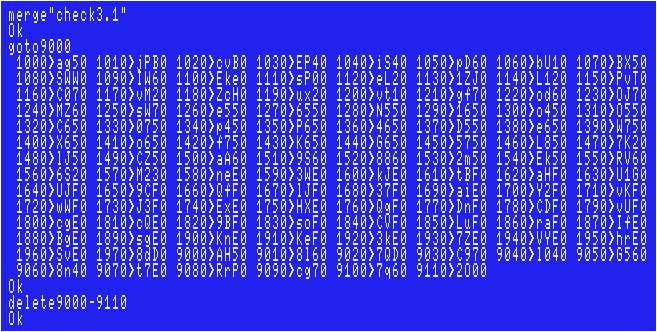
Sorry if there are any typos.
Run this file. "MAZEMAP3.DAT" will be created on the same diskette.
The 6th file named "MAZESAV4.BAS":
Original file name was "SAVE4", but I'm assuming that you're managing a huge amount of MSX games' files.To load the game from your diskette, modify the line #1060 as below.
If you modify the code as described above, each checksum will change as follows (using version3.1 coded by the "MSX•FAN" team).
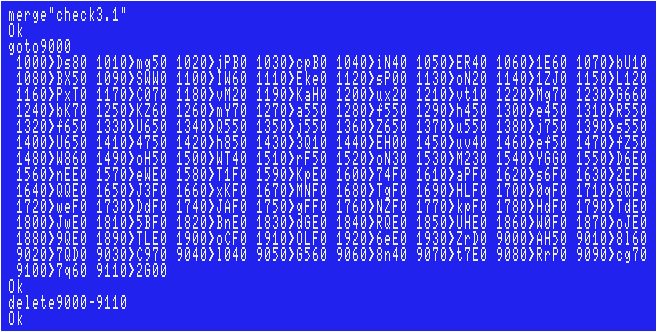
Sorry if there are any typos.
Run this file. "MAZEMAP4.DAT" will be created on the same diskette.
To load the game:
Have you already created "MAZEMAP1.DAT" ~ "MAZEMAP4.DAT" on the same diskette?
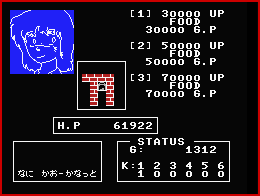 Just run the 1st file named "MAZEFONT.BAS".
Just run the 1st file named "MAZEFONT.BAS".Joystick support:
The 2nd file:"STICK(0)" is found in the line #450. "STRIG(0)" is also found in the line #450.
The quickest way is to simply replace each "0" with "1". In addition, you should modify some lines.(Sorry, omitted!)
Secret Room
| Author: |
M&M |
| Release: |
"POPCOM" Aug. 1986 Issue |
| Program length: |
24 screens |
Notes:
In the line #3090, CHR$(176) is used. CHR$(45) is not used. In addition, it would be better if you modify following lines.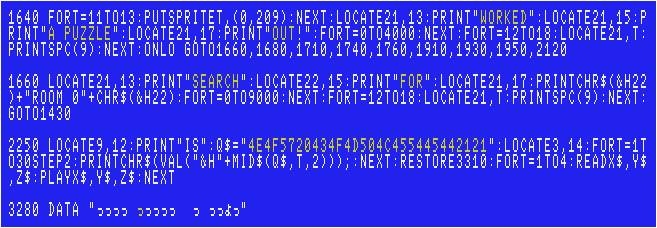
The line #3280: The "POPCOM" logo had become "PCPCOM".
Other lines: Strange English. "You work out a puzzle."(The line #1640), "You must search room 0"(The line #1660) and "Secret room is come to an end."(The line #2250)
If you modify the code as described above, each checksum will change as follows (using version3.1 coded by the "MSX•FAN" team).
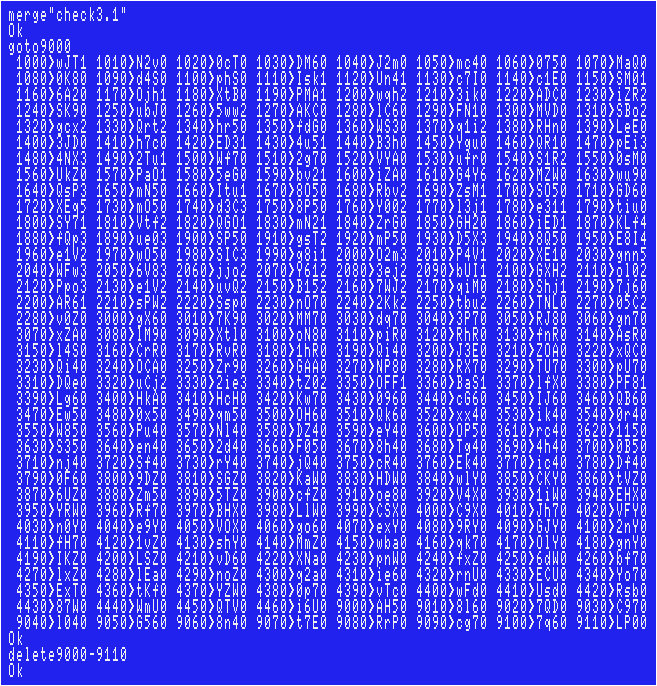
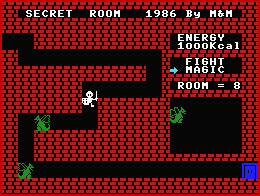 Sorry if there are any typos, however, I tested my data, including the ending, and had no problems.
Sorry if there are any typos, however, I tested my data, including the ending, and had no problems.Joystick support:
Although this game originally supports joystick, it would be better if you modify the following lines.
Trigger 1: Yes., Trigger 2: No.
SNES+AD adapter users must use a virtual keyboard to enter the secret number, sorry!
For modern emulator users:
It may be hard to control your main character. Either redefine Joystick's D-pad to any keys other than directional keys, or delete one of "STICK(0)+STICK(1)".
"STICK(0)+STICK(1)" is in the lines #1300, #1590, #1770 and #2030.
For Amiga CD32+FDD users and SNES+AD adapter users:
Unfortunately, neither "AmiMSX", "fMSX"(Amiga port), nor "MSXAdvance" can emulate "On Sprite Gosub" command.When you use "AmiMSX" or "fMSX"(Amiga port), nothing happens even though your main character collides with an enemy.
The only way to solve the root problem is to delete that "On Sprite Gosub" and define collision detection by specifying coordinates instead.
The Balls
| Author: |
Hiroyuki Tachibana |
| Release: |
"POPCOM" Nov. 1986 Issue |
| Program length: |
12 screens |
[Construction mode] 1: Choose the tile of wall., 2: Choose the tile of the goal point., 3: Delete a tile., 4: Update RAM data.,
5: Load each map data to the screen., 6: Delete all tiles on the screen., 7: Save all map data of RAM to your tape (or diskette).
For Disk users:
This game is originally for tape only. This is because part of the program's area of use overlaps with the 1st disk's work area.To load the game on Disk Basic, modify the code as below.
The 1st file:

If you modify the code as described above, each checksum will change as follows (using version3.1 coded by the "MSX•FAN" team).
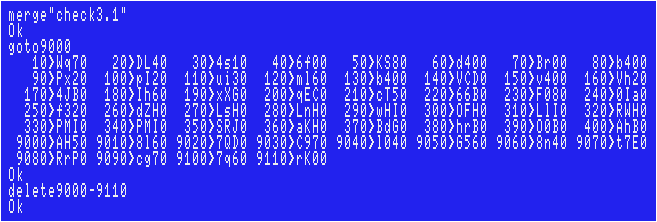
Sorry if there are any typos, however, I tested my data, including the ending, and had no problems.
The 2nd file named "BALLS2.BAS":

If you modify the code as described above, each checksum will change as follows (using version 3.1 coded by the "MSX•FAN" team).
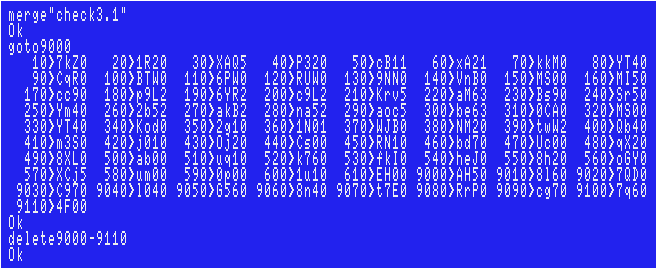
Sorry if there are any typos, however, I tested my data, including the ending, and had no problems.
The 3rd file named "BALLS3.BIN":
Original file name was "MAP", but I'm assuming that you're managing a huge amount of MSX games' files.You cannot even save this dump file on Disk Basic using the monitoring program coded by MSX Magazine.
First, enter all data using a binary editor on Windows to create one.
In such cases, we Japanese usually use freeware called "DumpWithRTCS".
Choose "Tool(T)">"Address Offset(A)...". Enter "E000". Then enter all hexadecimal numbers to E527H.
Don't forget to compare each checksum with that in the magazine. (Choose "Checksum(C)">"Add8(E)")
Finally add a header. (FE00E027E500E0)
The 4th file named "BALLS4.BAS":

If you modify the code as described above, each checksum will change as follows (using version 3.1 coded by the "MSX•FAN" team).
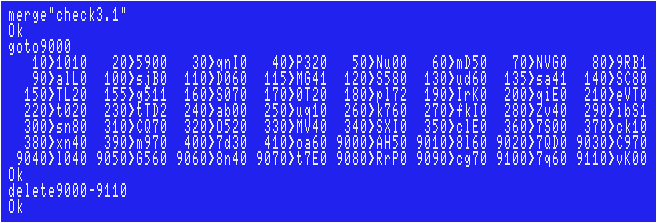
Sorry if there are any typos, however, I tested my data, including the ending, and had no problems.
The 5th file (The "memory monitoring" program):
You don't create this file if you use "DumpWithRTCS" described above.The 6th file (The "checksum" program):
You don't create this file if you use "DumpWithRTCS" described above.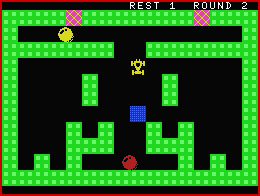 To load the game, run the 1st file.
To load the game, run the 1st file.Joystick support:
The 2nd file:"STICK(0)" is found in the line #60. "STRIG(0)" is also found in the line #60.
The quickest way is to simply replace each "0" with "1". In addition, modify the following lines.

Now you don't have to press "1" ~ "3" keys at the title screen anymore! Trigger 2: Restart the current level.
However, use a keyboard when you enter the construction mode.
For Amiga CD32+FDD users and SNES+AD adapter users:
Unfortunately, neither "AmiMSX", "fMSX"(Amiga port), nor "MSXAdvance" can emulate "On Sprite Gosub" command.When you use "AmiMSX" or "fMSX"(Amiga port), nothing happens even though your car collides with a ball or two balls collide each other.
The only way to solve the root problem is to delete that "On Sprite Gosub" and define collision detection by specifying coordinates instead.
Modify the code as below.
Other POPCOM games:
"Chitei Tanken Hiko", "Gem" and "Hero-X"
"Crystal" and "Genius"
"Chas!", "The Ghost", "Gun-Fighter" and "Super Ilevan"
Other role-playing games
>>Return to the "Type-in MSX programs" page






